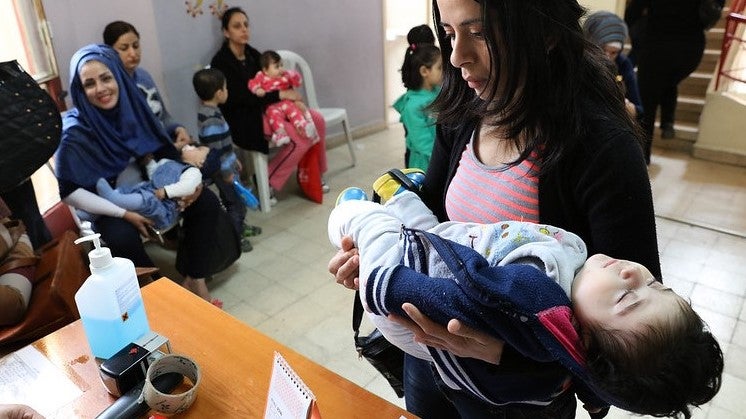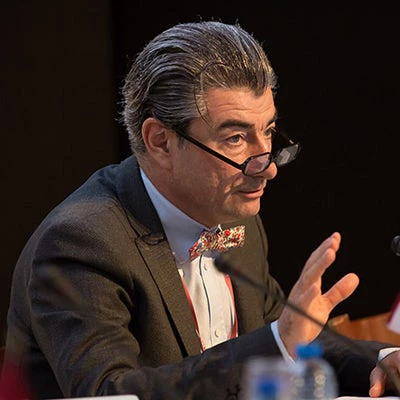 Howard Karagheusian primary health care center in Beirut, Lebanon. © Dominic Chavez/World Bank
Howard Karagheusian primary health care center in Beirut, Lebanon. © Dominic Chavez/World Bank
From treating a simple wound that gets infected, to providing post-surgery care for complex, chronic patients, antibiotics have been a critical tool in global health. These powerful medications have enabled advances in maternal and child health, reduced inequalities, and alleviated poverty. However, growing antimicrobial resistance (AMR), means that relying on antibiotics is no longer a given.
At present, AMR claims at least 700,000 lives worldwide. By 2050, it will claim 10 million lives per year, at a cost of $100 trillion to the global economy through lost productivity. AMR also has the potential to push 28.3 million more people into extreme poverty by 2050, with the vast majority (26.2 million) living in low-income countries. Ensuring that we can still use antibiotics is a key part of building the resilience of health and economic systems.
What is AMR and what causes it?
AMR occurs when microorganisms (bacteria, viruses, fungi and parasites) no longer respond to antimicrobial medications that were previously effective. As bacteria become more resistant to antibiotics, they can become untreatable and lead to superbugs. Simply put, it’s when the drugs stop working.
AMR is caused by a variety of factors including the misuse and overuse of antimicrobial drugs in human and animal health. Environmental factors can also exacerbate the spread of resistance, especially when water sanitation and supply systems are weak and become polluted with resistant genes, bacteria, and antimicrobial compounds.
What can we do to help prevent the spread of AMR?
There are many actions we can take to improve the resilience of our health systems and our ability to continue to use antibiotics to treat infections. Two areas, which go hand-in-hand with building resilient health systems, are infection prevention and control, and multisectoral surveillance systems.
Infection prevention and control
Wash your hands! The global outbreak of COVID-19 (coronavirus) has made handwashing common place and well-understood as a public health action. Hand hygiene stops the spread of pathogens that can make you sick and vulnerable to further infection in everyday settings.
In hospital settings, for health workers and patients, hygiene is even more important. In 2017, it was estimated that 7-10% of patients would encounter at least one hospital-acquired infection for any given treatment. Many of these infections can be prevented by improving hand hygiene practices within hospitals and infection control measures. An infection that is prevented is one that does not require antimicrobials.
However, a significant proportion of the world’s population doesn’t have access to clean water and sanitation systems. Globally, in 2017, one in four health care facilities has no basic water services, while one in five lacks sanitation services. 42% of health care facilities have no hand hygiene at points of care, and 40% have no systems for waste segregation. In these settings, investments in water and sanitation systems are critical. Ensuring that communities, hospitals, and schools have clean water and sanitation systems can stop the spread of disease and the prevent the misuse of antibiotics.
Multisectoral surveillance systems
Understanding how diseases are spreading and communicating this information across institutions in different sectors helps to prevent further diffusion. As information about resistance to a given pathogen is shared between human, veterinary and wildlife health services, it becomes easier to locate and manage the spread of AMR. Epidemiological surveillance systems that are integrated across sectors are a building block for human and animal health security, as they allow for the timely detection and response to health threats, including AMR.
Surveillance systems are even more useful when they can foster collaboration and coordination across different disciplinary agencies and provide a foundation for coordinated action. Data from multisectoral surveillance systems can inform discussions about prioritizing investments. Integrating systems can also help to build a culture of shared ownership in the fight against superbugs. As specialists across different disciplines draw on shared surveillance systems, they can also build familiarity and understanding across the One Health spectrum. This is all the more important when AMR transcends sectoral and geographical boundaries (much like COVID-19).
In 2016, the cost of improving global health security systems (including surveillance systems) was estimated to be $4.5 billion per year. Following the COVID-19 pandemic, AMR’s potential cost to low-income countries of more than 5% of GDP makes it clear that early, preventative investment in health surveillance systems stands to save lives and economies.
More research and work are needed to understand the emergence and spread of AMR. Yet it is clear that as we look to build resilient health systems in the wake of a global pandemic, infection prevention and surveillance systems have never been more likely to protect people, not only from COVID-19, but also from other deadly killers such as AMR.





Join the Conversation